This season has seen a deluge of products, with two premier expansions (Dominaria United and Brother’s War), two Jumpstart releases, and several Commander products (DMU, BRO, 40K, starter Commander decks), not to mention several Secret Lairs and 30th Anniversary Edition. Amidst all of that, it was easy to miss the season’s big supplemental set, Unfinity, which released the very same day as the Warhammer 40K decks (thanks to product delays caused by the pandemic). So today, I’d like to discuss my impressions of and experiences with Unfinity.
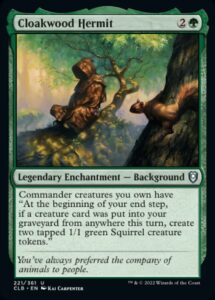
But first, a bit of background
Before we get into Unfinity itself, I think it’s worth talking about my experiences with Un-sets. After all, the reviewer’s biases absolutely color their reviews, and Unfinity isn’t a product intended to appeal to all audiences. And I have expressed strong opinions about Un-sets. For most of my life, I was against them. Unglued was funny to look at, but even as a kid, the cards felt lesser, like people weren’t supposed to actually play with the cards, just look at them.
As an adult, that made Un-sets seem nonsensical to me—if people felt like they couldn’t play with the cards, then how could Wizards justify the resources to produce something most people would either look at (but not collect) or outright ignore? Unhinged, with its immature butt jokes and awful Gotcha mechanic came along and calcified those opinions. By the time Unstable was announced, I was so displeased I wrote not one, but two articles about why Un-sets weren’t worth it.
Boy, was I wrong. Unstable was designed not only to be played, it was the first Un-set designed to be drafted by itself. It was a nuanced, silly, and awesome Limited format that’s cracked my top 10 Limited formats of the decade. It turned me from an enemy of Un-sets into an evangelist, from someone who only looked at silver-bordered cards to someone who collected and cubed with them. So, hopefully that gives you a sense of what I like in an Un-set and what I don’t.
I entered Unfinity preview season with excitement and optimism, whereas for Unstable’s, I was not at all enthusiastic. I didn’t have much bandwidth to pore over spoilers due to them overlapping with the Jewish holidays, so my first experience with Unfinity would be a draft at my local game store.
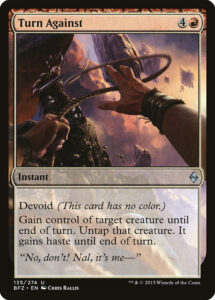
A hostile user experience
My first impressions of Unfinity were mixed at best. There is a lot of text on cards, a lot of cards with relatively unique effects, and not the most intuitive draft archetypes. I have a high appetite for complexity, but I found the draft difficult to navigate. It was easy to figure out what colors were most open at my seat but difficult to figure out what those colors are supposed to care about. As I played, the format came into focus and I had some real fun in my games. That said, there were a lot of pain points along the way.
Tables got cluttered every single game. Board stalls can already take up most of the available table space at a New York City game store; add in needing room for three sticker sheets, multiple attractions, and the many, many tokens that can show up in a game of Unfinity and there simply wasn’t room for everything. These cluttered board states made it much harder to keep track of game objects. Moreover, the sheer volume of game actions which needed to be taken (getting and tracking tickets, peeling off and applying stickers, rolling for and resolving attractions) combined with this complexity to force multiple matches to time every round.
There were also little things, like my Fight the _____ Fight (which I’d taken in pack 1) turning out to be awful after none of my stickers happened to contain long words. Or me missing over and over again with Dart Throw and feeling embarrassed. Or trying to decipher hats and limbs in card artwork. It’s normal for there to be less than positive experiences in Magic—variance is a core part of the game. But I found I was laughing less and having less fun than I was with Unstable, while I was feeling lousy in ways I never do with Magic. Sure, I enjoyed the simplicity of rolling for attractions (it was reminiscent of Unstable’s contraptions, which I loved), but the experience felt incomplete, like the design still had a bunch of kinks to work out.
And that brings us to the elephant in the room.
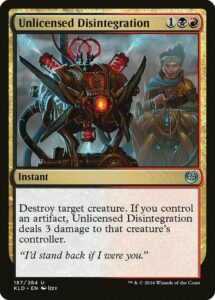
Stickers
As the night went on, stickers went from being a cute quirk to annoying and frustrating. Anyone who’s played with stickers knows that they don’t re-adhere well—that was a deliberate choice Wizards made so that players’ cards wouldn’t get damaged. By the end of the night, the stickers I’d been using were blowing away from the gentlest of breezes and sticking to themselves. But there’s more to them than that—they took a lot of mental energy.
Each sticker sheet has ten properties to track. Even if you only keep track of ability and power/toughness stickers, that’s twelve modifications to keep in mind. The name and art aspects of stickers were almost never relevant, and when they were, it was parsing numbers of vowels and word lengths—good ways to convert names into semi-random number generators, but not activities I found fun.
Worst of all was the upkeep. The end of a game of Magic has a rhythm to it—you scoop up your cards, sideboard, shuffle, and start playing. Stickers added another 30-60 seconds to this process. Each sticker needed to be collected, returned to its home on its sticker sheet, and pushed down forcefully so it re-adhered. It’s a little thing, but these little things add up—especially when the set already is so high on game actions, games run late, and each player has seven stickers to put away.
Stickers demanded a large mental load, too much table space, and its own resource system, but hardly seemed to justify that work in the games I played. I’ll note that those feelings are in spite of the fact that I won most of my games through ability and power/toughness stickers—stickers did great work for me! My user experience with them was bad. It colored the entire evening and caused me to shy away from stickers in my second Unfinity draft.
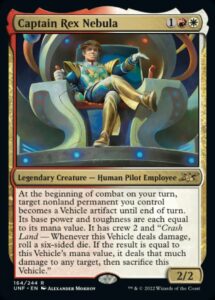
The perfect Unfinity experience
I had the pleasure of drafting Unfinity again, at Magic 30, with 400 hundred people and Mark Rosewater facilitating. It was the ideal conditions in which to play Unfinity. I got to Carnival Barker for an audience of over 400 people. I completed one of MaRo’s wild achievements (playing four cards from an Opening Ceremony) before anyone else. I made sure to draft a deck around attractions (which I knew I enjoyed) rather than stickers (which I knew I didn’t). I made a point of playing to have fun with my opponents rather than trying to win.
I had fun moments, but the overall experience was merely fine. The people around me during the draft seemed more overwhelmed than excited. People’s Carnival Barker speeches went from eliciting thunderous applause at the beginning to perfunctory applause as people largely ignored the speeches and went back to their games as quickly as possible. The event ran very long and many of the people I spoke to after round two were tired and wanted to leave rather than keep playing. I wasn’t sure how my Devil K. Nevil worked (it succeeds if it clears all its creatures but then flies off the table), but neither me nor my opponent wanted to stop and watch a three-minute instructional video to confirm that Nevil worked contrary to our intuitions, because homework doesn’t make cards more fun. (And do note that with Wizards’ new website still getting to full functionality, DevilKNevil.com is a broken link.)
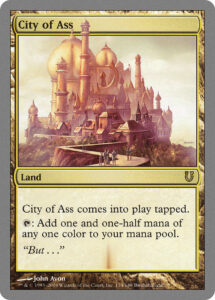
In conclusion…
Unfinity felt like a regression to the mean. Many cards were fun to look at, but fewer were fun to play with. The overall experience felt unpolished, like the cards (and especially stickers) weren’t playtested sufficiently—and that almost certainly was the case thanks to Covid lockdowns hitting right as Unfinity entered set design. I’m not sure if the experience of using these stickers ever got playtested before the files were locked. It just feels like there are too many ideas in the set, that more editing would have cut it down to something more coherent and enjoyable, but Mark, Ari, and the teams did the best they could under the lousy circumstances rather than delay the product by years.
Unfinity likely also suffered due to how Magic has changed since Unstable. Most sets nowadays have comedy, full-art lands, and alternate card styles. Secret Lairs do wild things with card art. Magic as a whole has absorbed and normalized the most broadly popular aspects of prior Un-Magic, making them less special in Unfinity. To compensate, we got shocklands (beautiful, but there are plenty of prestige treatments for them), black border Un-Commanders (which people have been asking for for years), and the blurring of the line between black-border Magic and silver-border, acorn Magic (a necessary step to get people to stop treating Un-cards as “not real”). Those are fine innovations, but they ultimately don’t enhance my primary method of engagement with Unfinity—drafting—and unfortunately, the draft experience mostly felt like a more complicated, less fun version of Unstable with far more busywork.
Looking to the future, I still hope that there’ll be more Un-Magic. There’s definitely an audience for it (again, Magic has absorbed and normalized many of the core elements of the first three Un-sets, from die-rolling to humor), but much of that audience may no longer need Un-sets to get their desired experiences. Time will tell whether Unfinity continues Un-set tradition of blazing new veins of design or if that crucible of invention has been absorbed into Magic’s other products. But I recognize that the next time there is an Un-set, I’ll be back to questioning whether this one is meant for me rather than just being excited for it.
Zachary Barash (he/him) is a New York City-based game designer and the last commissioner of Team Draft League. He designs for Kingdom Death: Monster, has a Game Design MFA from the NYU Game Center, and does freelance game design. When the stars align, he streams Magic (but the stars align way less often than he’d like).

